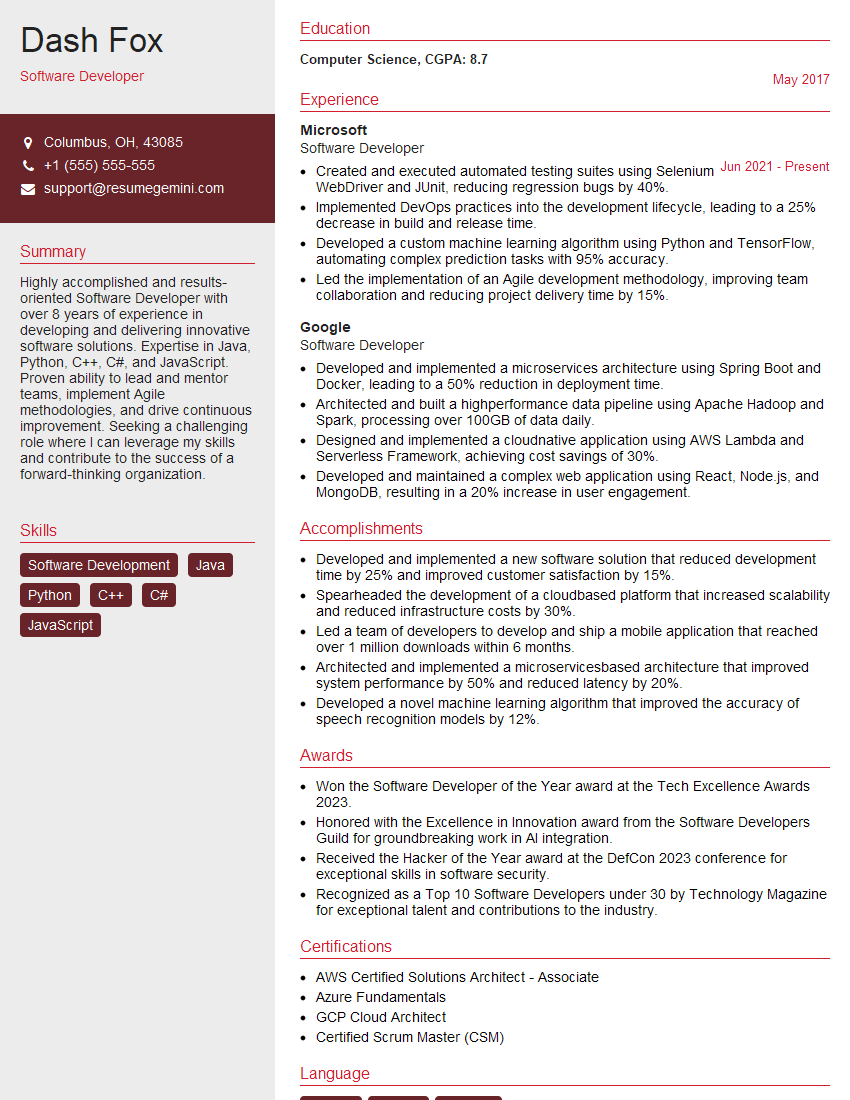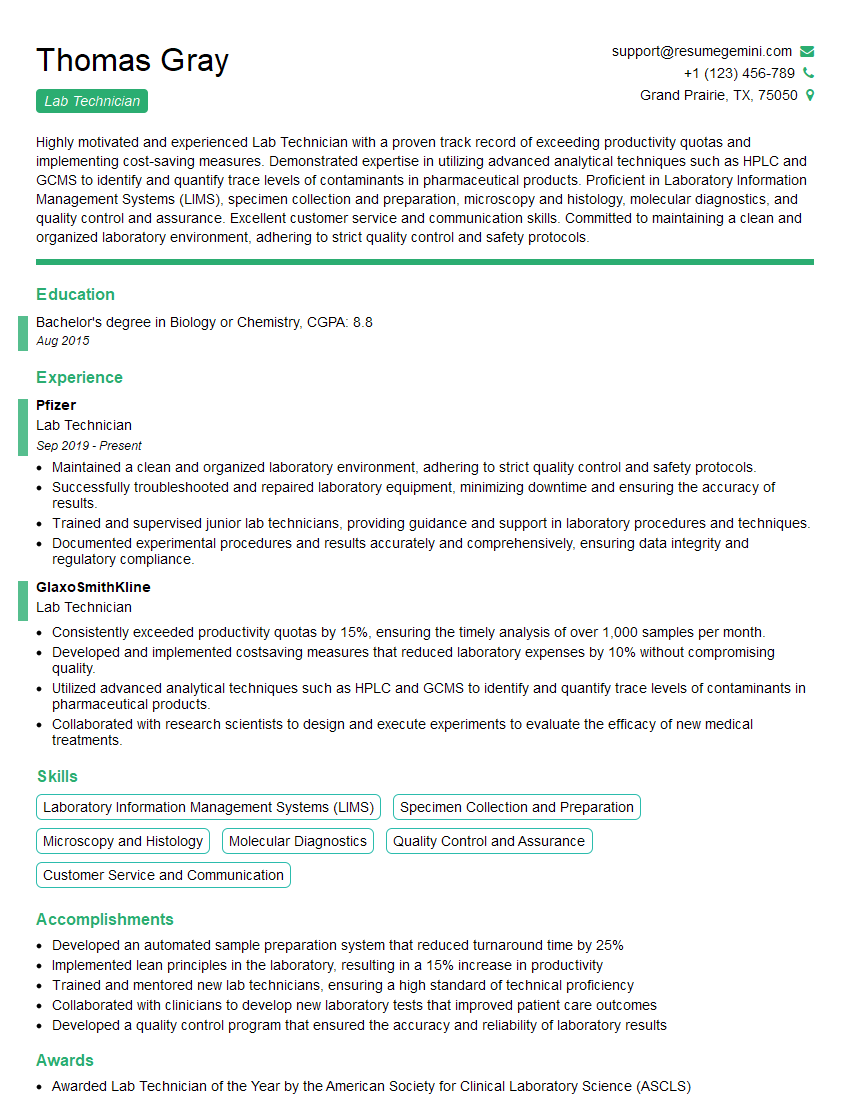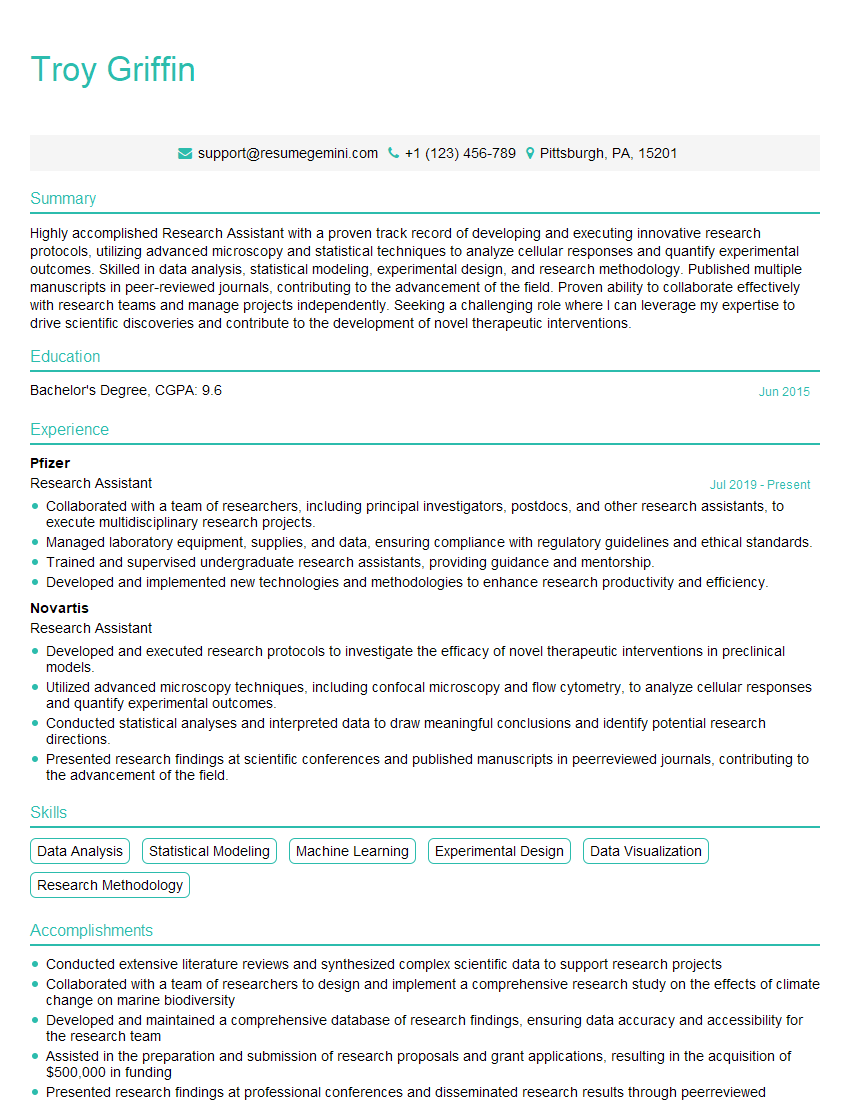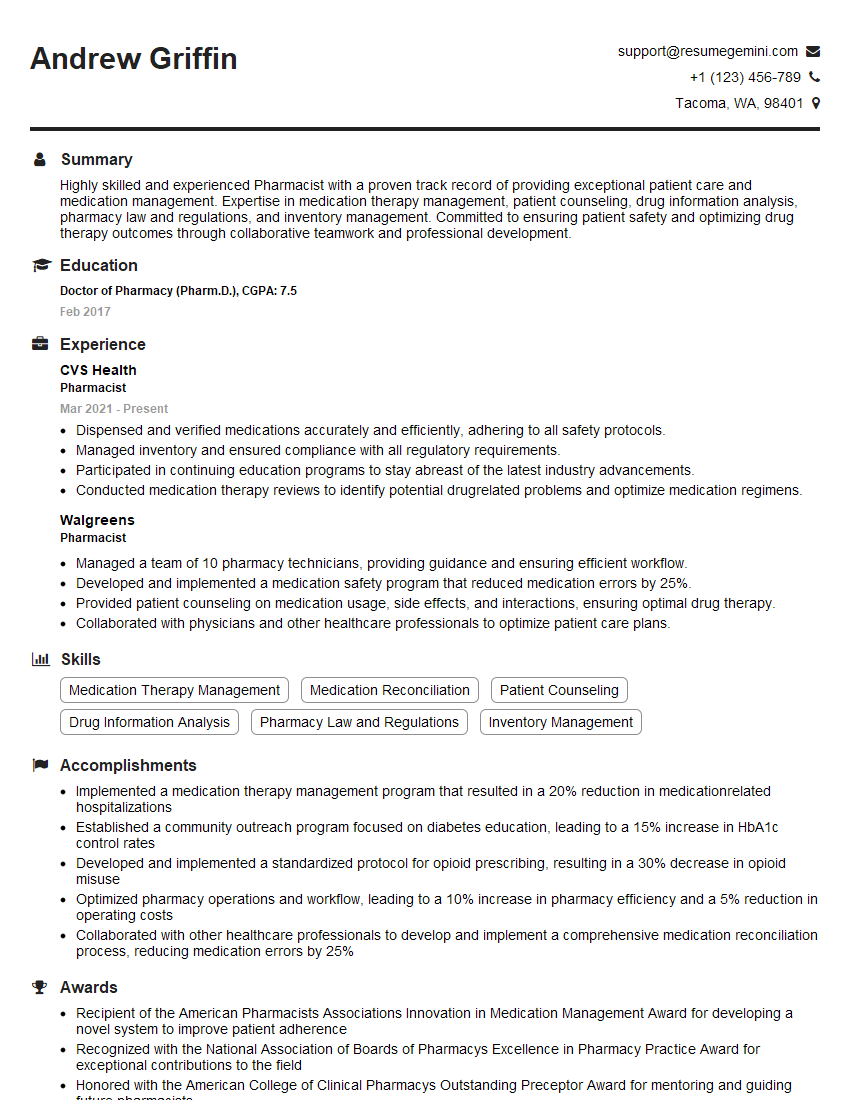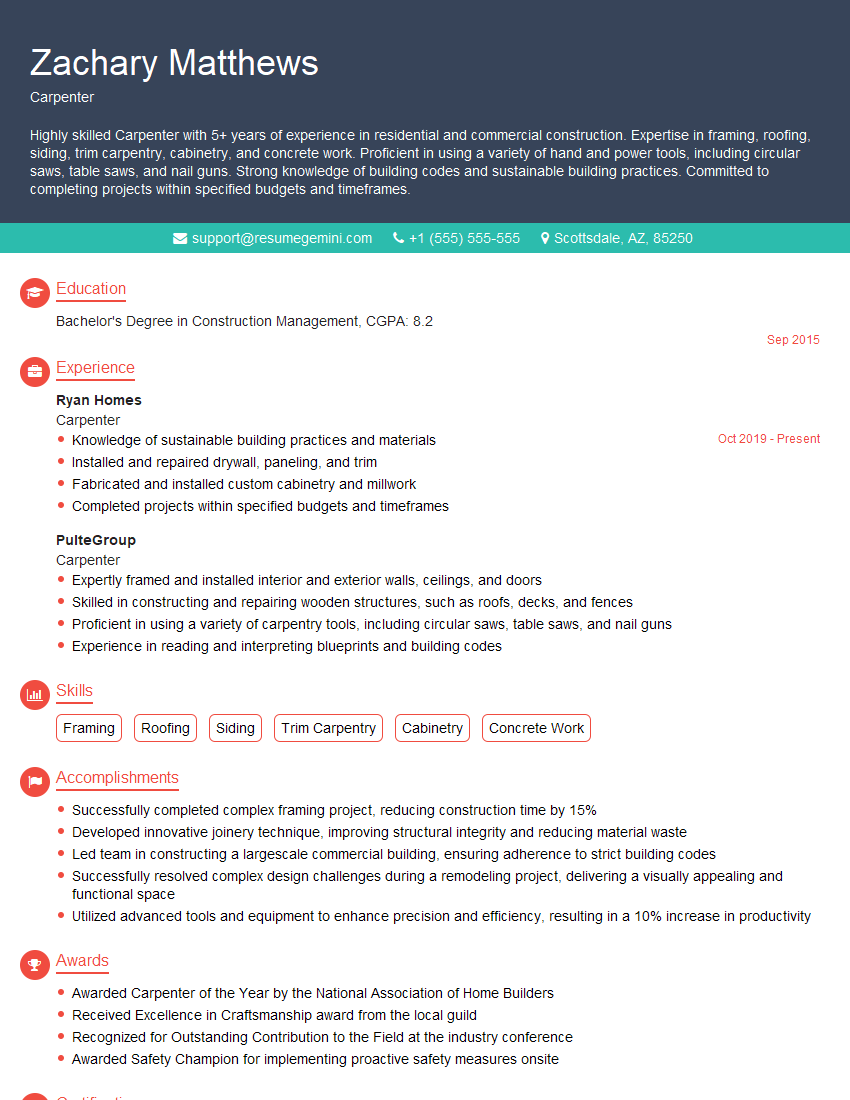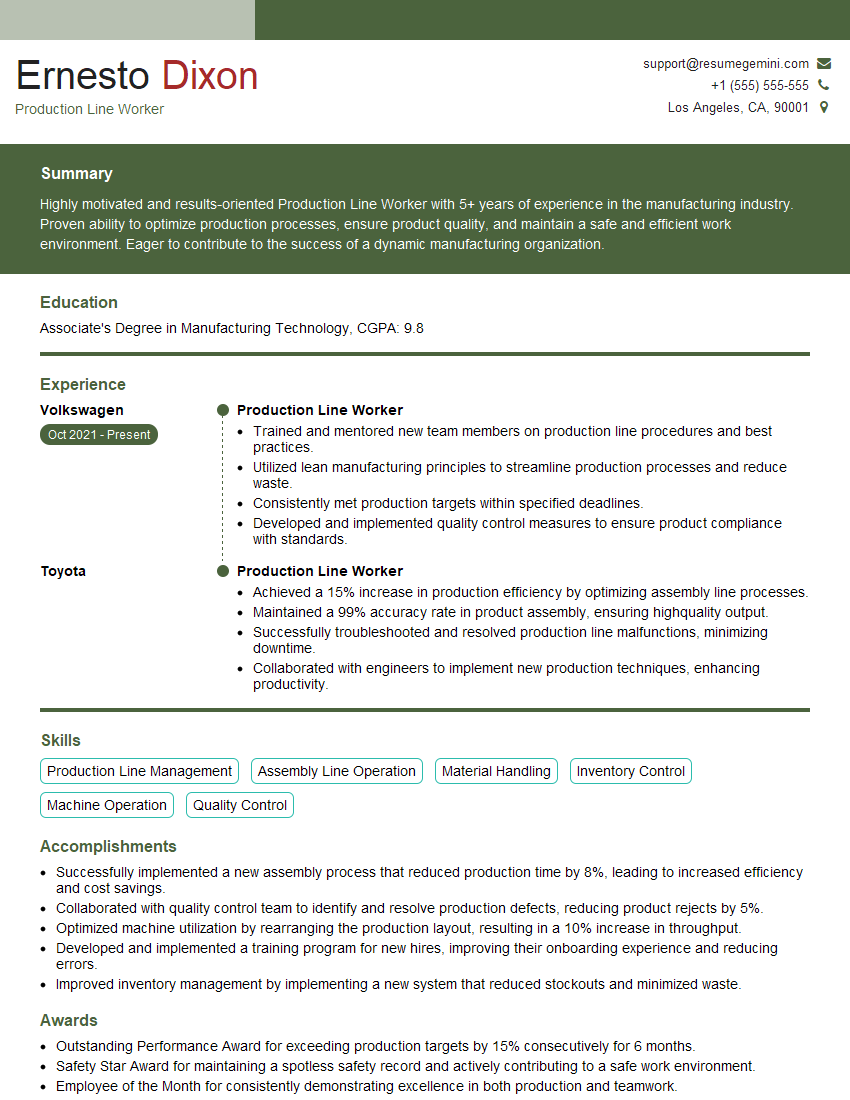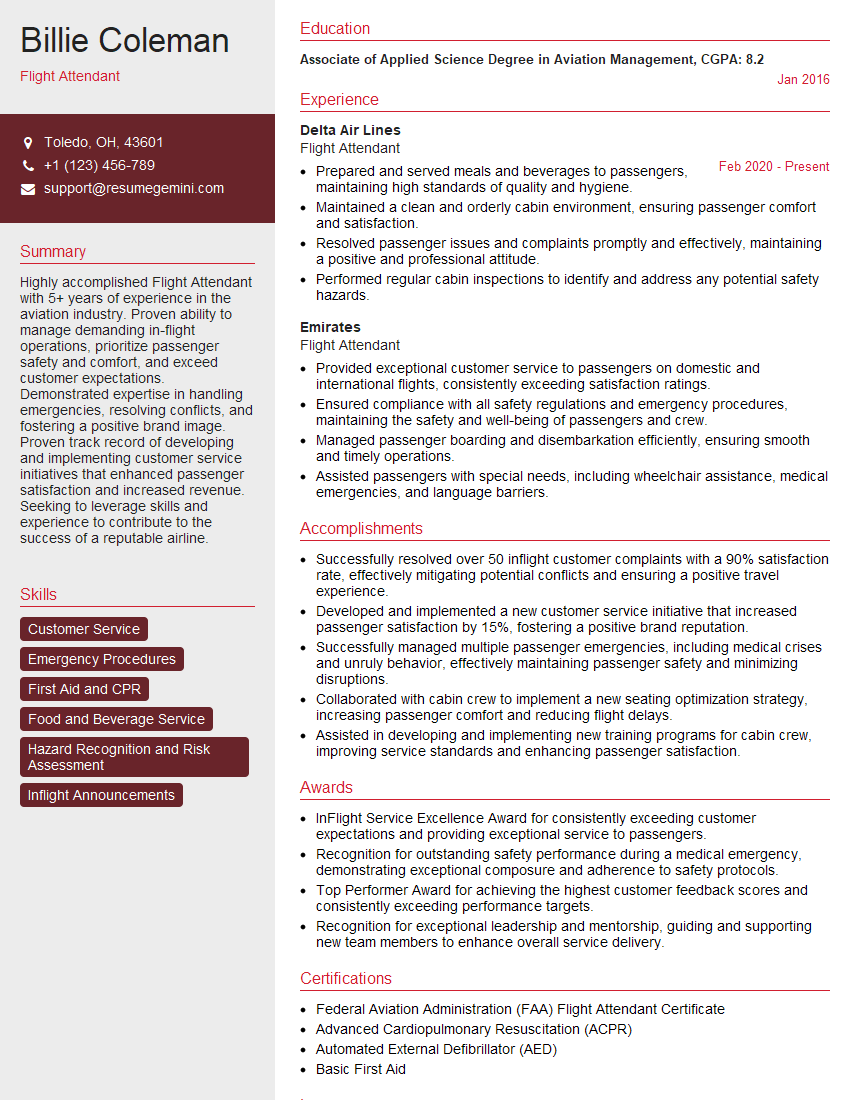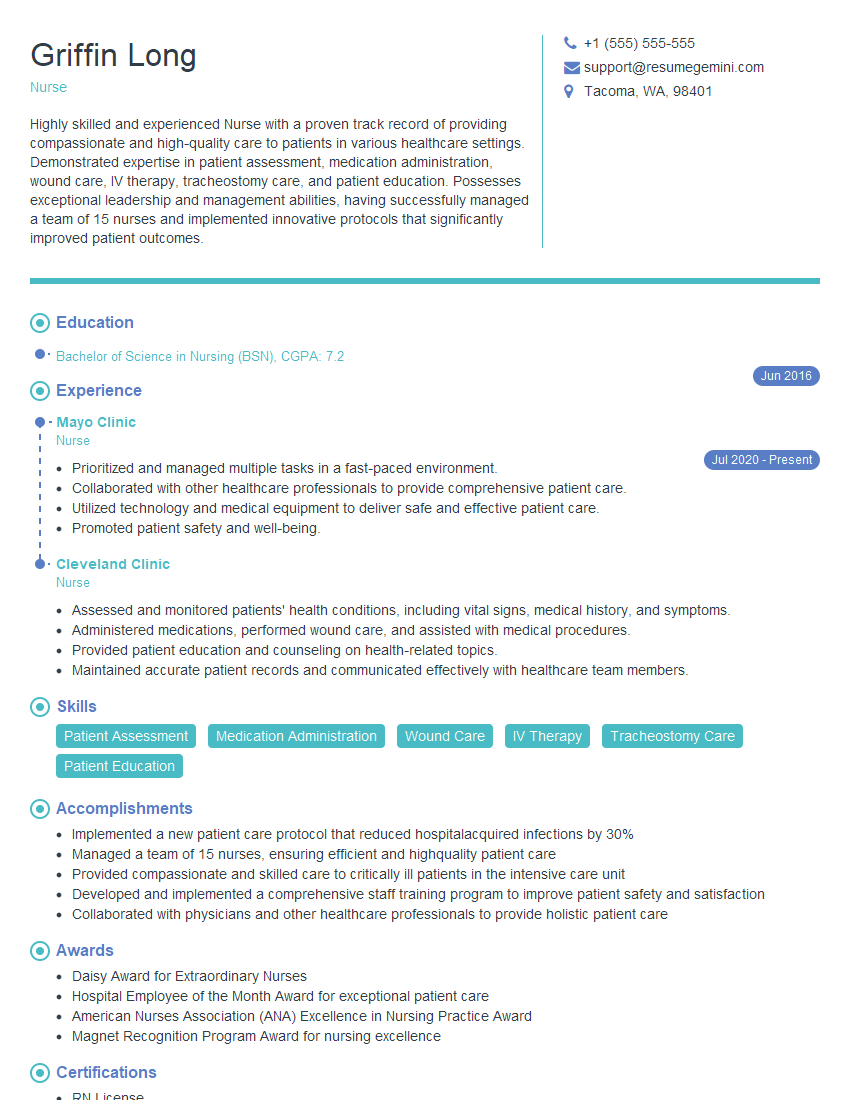The thought of an interview can be nerve-wracking, but the right preparation can make all the difference. Explore this comprehensive guide to Ability to follow instructions and directions effectively interview questions and gain the confidence you need to showcase your abilities and secure the role.
Questions Asked in Ability to follow instructions and directions effectively Interview
Q 1. Describe a time you had to follow complex, multi-step instructions.
Following complex, multi-step instructions is a cornerstone of effective work. It requires a structured approach, meticulous attention to detail, and the ability to break down large tasks into smaller, manageable components.
For example, during my previous role at a software development firm, I was tasked with configuring a complex server environment. This involved setting up several virtual machines, configuring networking parameters, installing specific software packages, and securing the entire infrastructure using a series of firewalls and access control lists. The instructions spanned dozens of pages, each step requiring precise execution. My approach was to first read through the entire instruction set to gain a holistic understanding. Then, I created a checklist, breaking down the process into logical phases, assigning each phase to a specific time slot and allocating resources effectively. This helped me avoid errors and stay on schedule. I also documented each step, recording the commands executed and the outcomes. This meticulous documentation ensured that I could easily track my progress and troubleshoot any problems that arose.
Q 2. How do you handle ambiguous instructions or conflicting directions?
Ambiguous or conflicting instructions are a common challenge. My approach is based on clarification and prioritization. First, I carefully analyze the instructions, noting any areas of uncertainty or discrepancy. Then, I attempt to reconcile the conflicting elements by looking for overarching goals or priorities. If this doesn’t resolve the ambiguity, I proactively seek clarification from the person who provided the instructions. This may involve asking clarifying questions, such as: “I’m noticing a discrepancy between step 3 and step 7 regarding X. Could you please help me understand which instruction takes precedence?” or “Step 5 is somewhat unclear to me. Can you provide more detail on Y?” This proactive approach ensures that I’m working with the most accurate and comprehensive information, minimizing the risk of errors or rework.
Q 3. What strategies do you use to ensure you understand instructions completely before starting a task?
Ensuring complete understanding of instructions is crucial. I employ several strategies, including:
- Careful Reading: I read the instructions thoroughly, not just skimming over them. I often read them multiple times to absorb the information completely.
- Visual Aids: If diagrams or flowcharts are provided, I carefully study them to gain a visual representation of the process.
- Summarization: After reading the instructions, I summarize them in my own words to verify my understanding. This helps identify any gaps in comprehension.
- Questioning: I don’t hesitate to ask clarifying questions if anything remains unclear. It’s always better to ask for clarification than to make assumptions.
- Breaking Down Complex Tasks: For multi-step processes, I break them down into smaller, manageable tasks to make the overall process less daunting and easier to understand.
Q 4. Have you ever made a mistake due to misinterpreting instructions? How did you handle it?
Yes, I have made mistakes due to misinterpreting instructions. In one instance, I was configuring a network device and misconstrued a setting related to IP addressing. This resulted in a network outage. My immediate response was to document everything – I meticulously recorded the steps I had taken, the error messages I encountered, and any changes I’d made. Then, I revisited the original instructions carefully, paying close attention to the section concerning IP addresses. By systematically reviewing each step and comparing it against the original instructions, I pinpointed the error. I corrected the misconfiguration and restored network functionality. Importantly, I also learned a valuable lesson about the importance of double-checking and clarifying any ambiguities before implementing instructions.
Q 5. How do you prioritize tasks when given multiple instructions simultaneously?
Prioritizing multiple simultaneous instructions requires a structured approach. I use a combination of techniques to manage this effectively:
- Prioritization Matrix: I use a simple matrix to prioritize tasks based on urgency and importance. This helps me focus on the most critical tasks first.
- Time Estimation: I estimate the time needed for each task and schedule them accordingly. This prevents me from getting overwhelmed.
- Time Blocking: I allocate specific time blocks for each task, preventing multitasking and ensuring focused effort on each individual task.
- Communication: If the deadlines are conflicting or the instructions are unclear regarding priorities, I promptly communicate with the relevant stakeholders to obtain clarity.
This system keeps me organized and ensures that tasks are addressed based on their relative importance and urgency.
Q 6. Describe your approach to verifying the accuracy of your work after following instructions.
Verifying the accuracy of my work is crucial. I employ a multi-layered approach:
- Self-Check: After completing each task, I perform a self-check, comparing my work to the original instructions and verifying that I’ve met all the specified requirements.
- Testing: Where applicable, I conduct thorough testing to ensure the accuracy and functionality of my work. This might involve testing software features or checking network connectivity.
- Peer Review: If possible, I seek feedback from a colleague. A fresh pair of eyes can often catch errors that I might have missed.
- Documentation Review: I review my work documentation to ensure its accuracy and completeness. This serves as a valuable audit trail for troubleshooting and future reference.
This systematic approach minimizes errors and ensures high-quality output.
Q 7. How do you handle situations where instructions are unclear or incomplete?
Handling unclear or incomplete instructions requires proactive communication and problem-solving. My approach includes:
- Identify Gaps: I carefully identify the specific areas where the instructions are unclear or incomplete.
- Seek Clarification: I proactively seek clarification from the person who provided the instructions. I clearly articulate the areas where I need more information.
- Make Reasonable Assumptions (with Documentation): If clarification isn’t immediately possible, I might make reasonable assumptions, documenting these assumptions clearly. This allows for a retraceable path in case the assumptions are later proven incorrect.
- Propose Solutions: If the instructions are significantly incomplete, I may propose possible solutions or alternative approaches, presenting them for review and approval.
This method ensures that I complete the task effectively while mitigating the risks associated with unclear or incomplete information. Documentation throughout is critical so I can transparently demonstrate my thought process and the steps I’ve taken.
Q 8. How do you stay organized when following multiple sets of instructions?
Staying organized when juggling multiple instruction sets is crucial for efficiency and accuracy. My approach involves a multi-pronged strategy focusing on prioritization, meticulous documentation, and leveraging organizational tools.
- Prioritization: I begin by identifying the most urgent and critical instructions, often using a matrix that considers both urgency and importance. This helps me focus my energy on tasks with the tightest deadlines or highest impact.
- Detailed Documentation: I maintain a comprehensive log of all instructions, utilizing a system that allows for easy referencing and tracking of progress. This might involve creating separate files or using a project management tool with task assignments and deadlines.
- Tool Utilization: I leverage tools like project management software (Asana, Trello, etc.), digital note-taking apps (Evernote, OneNote, etc.), or even simple checklists to keep all information organized and readily accessible. Color-coding or tagging can further enhance clarity and ease of navigation.
For example, in a previous role managing multiple software development projects, I used Trello boards to organize each project’s tasks, deadlines, and related instructions from different stakeholders. This ensured I could seamlessly switch between projects without losing track of what needed to be done and for whom.
Q 9. Can you give an example of when you had to follow instructions that were difficult or tedious?
During a large-scale data migration project, I encountered incredibly tedious instructions involving meticulous data validation and transformation. The process required following a complex series of steps for each data point, necessitating precise attention to detail and consistent adherence to specifications. The sheer volume of data and the complexity of the transformations made it an arduous task.
To overcome this challenge, I broke down the instructions into smaller, more manageable chunks. I created a detailed flowchart outlining the steps and developed a custom script to automate parts of the process where possible. This significantly reduced the time required and minimized the risk of errors. Regular breaks and self-checks were also critical to maintaining focus and accuracy throughout the lengthy process.
Q 10. Describe a time you had to adapt your approach to following instructions due to changing circumstances.
Adaptability is key when dealing with evolving instructions. During a marketing campaign launch, an unforeseen technical issue forced us to adjust our rollout plan. The initial instructions focused on a phased social media rollout. However, due to a website bug, we had to shift our strategy and focus on resolving the bug before proceeding with the social media campaign.
To address the change, I quickly reviewed the revised instructions, prioritized bug fixing as the immediate need, communicated the change to the team, and adjusted our project timeline accordingly. This involved effective collaboration with the technical team to quickly resolve the issue while minimizing disruption to the overall campaign launch schedule.
Q 11. How do you ensure you are following safety regulations and procedures?
Safety is paramount. My approach to adhering to safety regulations and procedures involves proactive measures, diligent training, and a commitment to reporting any potential hazards.
- Proactive Review: Before commencing any task, I thoroughly review all relevant safety guidelines, manuals, and procedures specific to the situation. This ensures I’m fully aware of the potential risks and the necessary precautions.
- Training and Certification: I actively participate in all safety training programs and ensure I’m appropriately certified for any task requiring specialized safety knowledge. I actively seek further training when needed.
- Hazard Reporting: I actively report any unsafe conditions or practices to my supervisor immediately. Preventing accidents is a shared responsibility.
In a previous role involving working with machinery, I always meticulously followed lockout/tagout procedures before performing any maintenance. This ensures the equipment was completely de-energized, preventing potential injury.
Q 12. Have you ever had to follow instructions from someone you disagreed with? How did you handle that?
Disagreements can arise, but professionalism dictates that instructions are followed, unless they are unethical or unsafe. In one instance, I disagreed with a manager’s instructions regarding a project timeline. I believed the deadline was unrealistic and could compromise quality.
Instead of openly contradicting, I respectfully presented my concerns and the potential consequences of rushing. I offered alternative solutions that addressed the manager’s goals while maintaining quality standards. This approach allowed for a collaborative solution where the timeline was adjusted slightly, ensuring project success without sacrificing quality.
Q 13. How do you manage your time effectively when following detailed instructions with deadlines?
Effective time management with detailed instructions and deadlines hinges on planning, task breakdown, and consistent monitoring.
- Detailed Planning: I start by thoroughly reviewing all instructions to understand the scope of work and identify potential roadblocks. I then create a realistic timeline, breaking down large tasks into smaller, manageable steps.
- Task Breakdown and Prioritization: Using tools like Gantt charts or Kanban boards, I visually represent the tasks, their dependencies, and deadlines. I prioritize tasks based on urgency and importance, focusing on critical path activities.
- Consistent Monitoring and Adjustment: I regularly track my progress against the timeline, identifying any potential delays or issues early on. Flexibility is essential; I’m prepared to adapt my schedule as needed to meet deadlines while maintaining quality.
For instance, when working on a complex report with a tight deadline, I created a detailed schedule outlining daily tasks and allocated specific time blocks for each. This allowed me to track progress and make adjustments if needed, ensuring I met the deadline without sacrificing the report’s quality.
Q 14. What is your process for asking clarifying questions when instructions are unclear?
Unclear instructions are addressed proactively through a structured questioning process.
- Review and Identify: I carefully review the instructions, identifying specific points of confusion.
- Document Questions: I create a concise list of clarifying questions, focusing on specifics rather than general inquiries.
- Appropriate Communication: I communicate these questions through the most appropriate channel (email, meeting, etc.), ensuring clarity and proper documentation.
- Seek Confirmation: After receiving clarification, I confirm my understanding of the updated instructions to avoid further misinterpretations.
For example, if instructions mentioned “optimizing the database,” I wouldn’t ask, “What does this mean?” Instead, I might ask, “To optimize the database, should I focus on indexing, query optimization, or data normalization, or a combination thereof?” This ensures a specific and actionable response, preventing misunderstandings.
Q 15. Describe a time you identified an error in instructions. What did you do?
Identifying errors in instructions is crucial for successful task completion. It requires a keen eye for detail and a proactive approach. In one instance, I was tasked with configuring a server using a provided manual. The manual instructed me to use a specific port number (8080), but I noticed that port was already in use by another service. Instead of blindly following the instruction, I investigated further. I checked the server logs and found a note indicating the correct port for that specific configuration was 8081. I then double-checked this with a senior colleague before proceeding, preventing a potential conflict. This highlights the importance of verification and seeking clarification when discrepancies are found.
Career Expert Tips:
- Ace those interviews! Prepare effectively by reviewing the Top 50 Most Common Interview Questions on ResumeGemini.
- Navigate your job search with confidence! Explore a wide range of Career Tips on ResumeGemini. Learn about common challenges and recommendations to overcome them.
- Craft the perfect resume! Master the Art of Resume Writing with ResumeGemini’s guide. Showcase your unique qualifications and achievements effectively.
- Don’t miss out on holiday savings! Build your dream resume with ResumeGemini’s ATS optimized templates.
Q 16. How do you utilize tools or resources to assist in following instructions?
Effective instruction following often involves leveraging various tools and resources. For example, when working with complex software or hardware, I frequently consult official documentation, online tutorials, and knowledge bases. I also make extensive use of checklists to ensure I don’t miss any steps. If the instructions involve programming, I will utilize debugging tools to identify and resolve errors promptly. For visual instructions, I might use screen recording software to replay and review complex procedures. The choice of tools always depends on the task’s nature and complexity.
Q 17. How do you handle interruptions while following instructions on a complex task?
Interruptions are inevitable, especially when working on complex tasks. My approach involves a systematic strategy to minimize disruption and maintain accuracy. First, I acknowledge the interruption politely but firmly indicate my current focus. If the interruption is urgent, I pause my work, carefully noting my current position in the instructions using bookmarks or similar tools. Once the interruption is resolved, I review my notes and double-check my position before resuming. For less urgent interruptions, I may postpone them until I reach a logical breakpoint in the task. This structured approach helps to maintain efficiency and reduce the risk of errors caused by abrupt changes in focus.
Q 18. How would you handle a situation where the instructions are outdated or incorrect?
Outdated or incorrect instructions are a significant challenge. My first step is to verify the instructions’ validity. I check the version number or last updated date. I also search for updated versions or newer documentation. If confirmed outdated, I would consult the relevant team or subject matter expert for updated instructions. If the instructions are demonstrably incorrect, I would again seek clarification, explaining the conflict and providing evidence from my investigation. If no updated instructions are available, I would document the issue clearly, detailing my findings and proposed solutions, before seeking approval to proceed with my proposed approach.
Q 19. Describe your method for documenting your work process when following instructions.
Careful documentation is crucial for accountability and reproducibility. My method combines digital and physical tools. I maintain a detailed log of my work, recording each step followed. This might include screenshots, timestamps, and notes explaining any decisions made. I use a combination of project management tools (e.g., Trello, Asana) to track progress, and a notebook for quick notes and sketches. If there are any deviations from the instructions, they are meticulously documented with the reasoning behind the deviation. This thorough record-keeping helps me to reproduce my work and serves as a valuable resource for future tasks.
Q 20. How do you confirm that you’ve completed all steps in a set of instructions?
Confirming completion requires a systematic approach. I always review the instructions thoroughly, checking each step against my work. This often involves comparing my results with expected outputs or using testing procedures specified in the instructions. If the instructions included a checklist, I meticulously mark off each completed item. I also often conduct a final review, seeking a second pair of eyes (when possible) to cross-check my work and identify potential oversights. This methodical process ensures that the task is completed accurately and completely.
Q 21. Describe your preferred method for receiving instructions (written, verbal, visual).
While I can adapt to various instruction formats, I find a combination of written and visual instructions to be most effective. Written instructions provide a clear and detailed record, easily accessible for review. Visual aids, such as diagrams, flowcharts, or video tutorials, complement written instructions, particularly for complex procedures. Verbal instructions can be helpful for quick explanations or clarifications, but I always prefer to have them supplemented by written documentation for future reference and unambiguous record-keeping. The optimal method depends heavily on the task’s complexity and the nature of the information being conveyed.
Q 22. How do you balance speed and accuracy when following instructions?
Balancing speed and accuracy in following instructions is a crucial skill. It’s not about rushing, but about efficient execution. I approach this by first thoroughly understanding the instructions, clarifying any ambiguities, and then creating a prioritized plan of action. This plan helps me break down complex tasks into smaller, manageable steps. I focus on accuracy in each step, employing self-checks along the way, to ensure a high-quality outcome. If time is a constraint, I will prioritize the critical aspects of the task and ensure their accuracy before moving to less critical parts. This method prevents careless errors that might arise from rushing. Think of it like baking a cake – you carefully measure ingredients (accuracy) and follow the steps methodically (speed), resulting in a delicious and well-made cake.
Q 23. In a team setting, how do you ensure you are following instructions consistently with others?
In a team setting, consistency is paramount. We establish a clear communication channel – perhaps a shared document or regular briefings – where all instructions are documented and discussed. Before beginning any task, I ensure I’m on the same page as my teammates, clarifying any uncertainties together. We actively check in with each other throughout the process, comparing our progress and identifying any discrepancies early. This collaborative approach helps maintain a unified understanding of the instructions and prevents individual deviations that could lead to inconsistencies in the final product. Think of it as a symphony orchestra – every player must follow the conductor’s instructions (instructions) precisely and in sync (consistency) to produce harmonious music.
Q 24. How do you handle conflicting instructions from different sources?
Conflicting instructions are a potential pitfall, but manageable with a structured approach. My first step is to identify the source of each instruction, evaluating the authority and relevance of each. If possible, I attempt to reconcile the differences – maybe one instruction is an update to an older one. If reconciliation isn’t possible, I escalate the issue to my supervisor or the relevant stakeholders to clarify the discrepancies. Documenting all instructions and the steps taken to resolve the conflict ensures accountability and prevents future issues. For instance, imagine two chefs giving conflicting instructions in a kitchen – the head chef’s instruction should always take precedence. My role is to be the efficient communicator and facilitator of a solution.
Q 25. How do you demonstrate your understanding of instructions to others?
Demonstrating understanding goes beyond simply saying “I understand.” I actively seek clarification if needed and then use various methods to show my comprehension. This could include verbally summarizing the instructions, creating a visual representation (flowchart, diagram), presenting a plan of action, or producing a draft of the final product for review. For instance, if given instructions to write a code module, I would show my understanding by providing pseudocode or a clear outline of the module’s structure before fully writing the code. This proactive approach ensures that everyone is on the same page and prevents costly mistakes down the line.
Q 26. What is your process for double-checking your work to ensure compliance with instructions?
My process for double-checking involves a multi-stage approach. First, I review my work against the original instructions, step-by-step, ensuring each point is addressed correctly. Then, I perform a second independent review, perhaps using a different method or perspective. Finally, depending on the task’s complexity and importance, I might ask a colleague to review my work for any potential errors or oversights. This thorough process helps me catch minor errors before they become significant problems, leading to higher quality deliverables and boosting overall productivity. It’s like proofreading an important document – a fresh pair of eyes can always spot something you missed.
Q 27. How do you adapt your approach to following instructions based on the individual providing them?
My approach to following instructions adapts based on the individual giving them. Some individuals are highly detailed and prefer explicit instructions, while others provide broader guidelines and encourage creative problem-solving. I adjust my communication style accordingly. With detailed individuals, I ask clarifying questions to ensure complete understanding. With those offering broad guidelines, I propose my plan of action and seek their approval before proceeding. This flexibility helps build strong working relationships and ensures optimal results regardless of the communication style. Consider it like tailoring your approach to different customers – one might prefer a detailed specification while another appreciates flexibility and innovation.
Q 28. Describe a situation where precise instruction following prevented a negative outcome.
During a critical software deployment, precise instruction-following prevented a major system failure. The deployment procedure had multiple sequential steps, each with stringent requirements. I meticulously followed each step, double-checking configurations and logging all actions. A minor oversight in one of the steps could have cascaded into a system-wide failure causing downtime. My adherence to the instructions, including thorough checks, ensured a smooth and successful deployment. This experience reinforced the importance of thorough instruction-following, especially in high-stakes situations.
Key Topics to Learn for Ability to follow instructions and directions effectively Interview
- Understanding Instructions: Learn to actively listen, identify key details, and clarify ambiguities before starting a task. This includes recognizing different instruction styles (written, verbal, visual).
- Prioritization and Time Management: Practice prioritizing tasks based on instructions and managing your time effectively to meet deadlines. Consider scenarios with competing priorities and explain your approach to resolving them.
- Attention to Detail: Demonstrate your ability to meticulously follow instructions, even those that seem minor or insignificant. Prepare examples showcasing how your attention to detail prevented errors or improved outcomes.
- Adaptability and Problem-Solving: Discuss how you handle unexpected situations or changes in instructions. Highlight your ability to adapt your approach and find solutions when faced with unclear or conflicting directions.
- Seeking Clarification: Explain your process for seeking clarification when instructions are unclear or ambiguous. This demonstrates proactive communication and a commitment to accuracy.
- Documentation and Record Keeping: Show how you document your work and track your progress, ensuring compliance with given instructions throughout the process.
- Self-Assessment and Improvement: Reflect on past experiences where you followed instructions effectively or where improvements could be made. Demonstrate self-awareness and a commitment to continuous learning.
Next Steps
Mastering the ability to follow instructions effectively is crucial for career advancement. It demonstrates reliability, competence, and a strong work ethic – qualities highly valued by employers. To enhance your job prospects, create an ATS-friendly resume that highlights these skills. ResumeGemini is a trusted resource that can help you build a professional and impactful resume showcasing your abilities. We provide examples of resumes tailored to effectively highlight “Ability to follow instructions and directions,” allowing you to create a compelling narrative that secures your next interview.
Explore more articles
Users Rating of Our Blogs
Share Your Experience
We value your feedback! Please rate our content and share your thoughts (optional).
What Readers Say About Our Blog
Hi, I’m Jay, we have a few potential clients that are interested in your services, thought you might be a good fit. I’d love to talk about the details, when do you have time to talk?
Best,
Jay
Founder | CEO







